
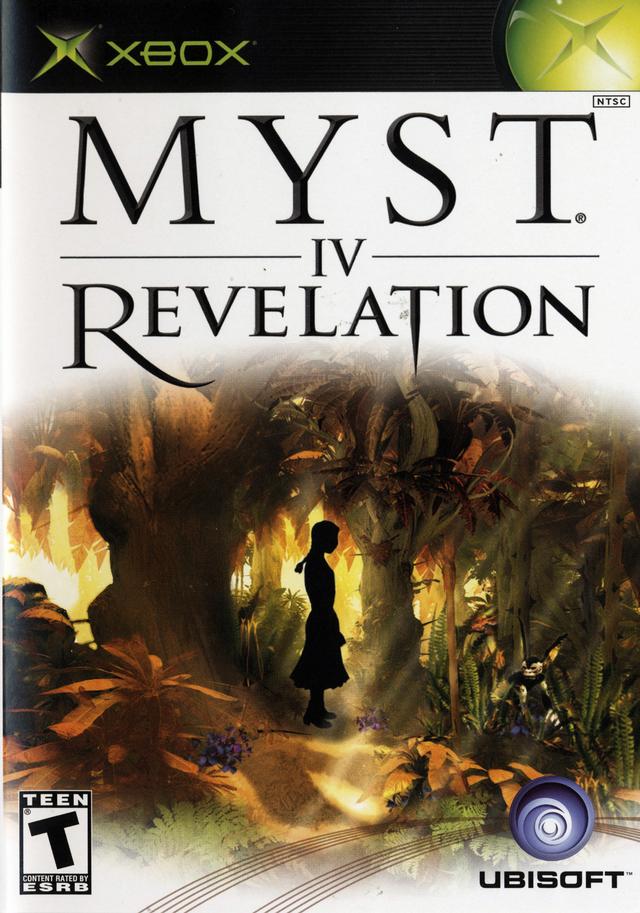
| Original Release Date | Publishers | Designers | Composers | Platforms | Storage Method | Game In Series |
| September 29, 2004 | Ubisoft | Patrick Fortier, Mary DeMarle, and Geneviève Lord. | Jack Wall and Peter Gabriel | Mac, Windows, Xbox | DVD-ROM (two disks) | Fourth |
| Original Technical Specifications for Windows | Processor | Operating System | Hard Drive Space | RAM | DVD-ROM | Graphics | Sound | Other |
| 700MHz Pentium III or faster | Windows 98SE, ME, 2000 or XP | 3 GB Free Space | 128 MB (256 MB for Windows XP) | 4x | 32 MB DirectX 9.0-compliant video card | Microsoft DirectX 9.0 Compatible | Microsoft DirectX 9.0 or higher |
| Original Technical Specifications for Macintosh | Processor | Operating System | Hard Drive Space | RAM | DVD-ROM | Graphics | Other |
| 700 MHz G4 or faster | Mac OS X 10.2 or greater | 3.5 GB | 128 MB | 4x | 32 MB video card (ATi Radeon 7500 to 9600 or better, nVidia GeForce 2/4/FX families) | Standard sound, QuickTime 5.0 |
The video game world was changing. New consoles like the Xbox, GameCube, and PlayStation 2 were dominating the marketplace, bringing with them new, high-tech games like Halo and a few remakes of some older favorites, such as the Tomb Raider and Resident Evil series – and the consoles themselves were also getting tech-savvy enough to rival PC gaming. The Myst series was, by now, a roaring success, with a devoted fanbase, an impressive legacy, and three games and a spin-off to its name. Not only that, but they had remastered, recreated, and re-released the game that started it all, Myst, not once, but twice! Cyan Worlds was in its prime and the Myst fan community was thriving. Unfortunately, Presto Studios had closed its doors after Exile, and Ubisoft was the only one left to take up the Myst mantle. Even though the company hadn’t originally wanted to create more games beyond Riven, the success of Exile was enough for them to reconsider and give Ubisoft the permission to make Myst IV: Revelation, the fourth in the series. Revelation excelled in new technology, with much more advanced graphics, a new real-time game engine called ALIVE, camera effects, and ambient effects such as moving clouds and swaying trees. The puzzles were a challenge, the ages were gorgeous, and two thought-dead characters returned, much to the surprise of the fans. All in all, Revelation broke even more game barriers than its predecessor, Exile, and proved to be a great success even though some fans found some of the plot events ‘too magical’ to draw them in.
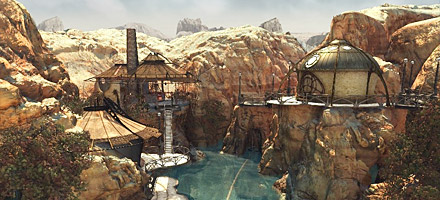 Myst
IV: Revelation is a return to the past as well as a glimpse into the future.
Atrus calls you to Tomahna again, this time to get your opinion on a very tough
family issue. It turns out that the trap books from Myst weren’t
quite trap books and Sirrus and Achenar, the evil brothers from Myst,
aren’t quite dead. Atrus, at Catherine’s suggestion, wrote in special
‘cages’ of sorts where he could enter and speak to his sons again.
Catherine, however, misses her boys terribly and wants at least one of them
home – but Atrus is unsure of which he can trust. Wanting a second opinion,
he asks you to help him out by coming with him to the brothers’ prisons
and speaking with them firsthand, the first time they have seen the player since
they were trapped nearly twenty years earlier. Before he can go, however, he
needs to tune up a new invention of his, the crystal viewer, and take a look
into the ages. Unfortunately, it breaks, and he has to leave to get something
to fix it. He does fix it, but he finds himself stranded, leaving you to fix
the power, turn on the viewer, and keep an eye on his ten-year-old daughter
Yeesha for him. Disaster strikes soon after you fix the power, however, and
you awaken at the bottom of a ravine to find Yeesha gone, leaving behind only
the scene of a struggle and a mysterious necklace that lets you see past events.
Now it’s up to you to find Yeesha – and discover who her kidnapper
is – before it’s too late.
Myst
IV: Revelation is a return to the past as well as a glimpse into the future.
Atrus calls you to Tomahna again, this time to get your opinion on a very tough
family issue. It turns out that the trap books from Myst weren’t
quite trap books and Sirrus and Achenar, the evil brothers from Myst,
aren’t quite dead. Atrus, at Catherine’s suggestion, wrote in special
‘cages’ of sorts where he could enter and speak to his sons again.
Catherine, however, misses her boys terribly and wants at least one of them
home – but Atrus is unsure of which he can trust. Wanting a second opinion,
he asks you to help him out by coming with him to the brothers’ prisons
and speaking with them firsthand, the first time they have seen the player since
they were trapped nearly twenty years earlier. Before he can go, however, he
needs to tune up a new invention of his, the crystal viewer, and take a look
into the ages. Unfortunately, it breaks, and he has to leave to get something
to fix it. He does fix it, but he finds himself stranded, leaving you to fix
the power, turn on the viewer, and keep an eye on his ten-year-old daughter
Yeesha for him. Disaster strikes soon after you fix the power, however, and
you awaken at the bottom of a ravine to find Yeesha gone, leaving behind only
the scene of a struggle and a mysterious necklace that lets you see past events.
Now it’s up to you to find Yeesha – and discover who her kidnapper
is – before it’s too late.
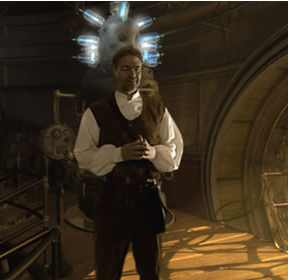
Myst IV: Revelation has a lot of characters for a
Myst game! There are three, but once again, Catherine gets short-shifted,
reduced only to her voice in a few flashbacks, so she’s not discussed
here. The least you need to know about her regarding this game is that she wrote
one of the ages, Serenia, which you will visit later. The first main character
is, once again, Atrus. He’s a pretty nice guy, but he’s rather scatter-brained.
In Revelation, Atrus wants you to help him with a little family issue
regarding his sons, but a few mechanical issues stall it and after attempting
to fix it from another age, he finds himself stuck there, leaving you to power
up the machine and finish the job. Atrus was once again portrayed by Rand Miller.
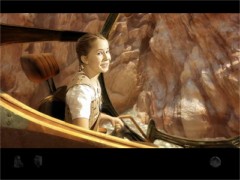
The second big character you should know about is Yeesha. Yeesha was only a
baby when we first met her in Exile, but in Revelation, she’s
ten years old and seems to have a mind of her own. She’s intelligent,
imaginative, and absolutely adorable. She knows quite a bit about her brothers,
but she doesn’t know why they have to live on different ages from her
home in Tomahna. She’s also a pawn in one of the brothers’ plot
against Atrus. A few fans tend to find her annoying or even downright creepy
because of how smart she is, but the vast majority of them are rather fond of
her – in this game, at least. Yeesha was portrayed by Juliette Gosselin,
a young lady from Quebec, Canada.
The third character is an old, familiar face, Sirrus. You might remember how
greedy and power-hungry Sirrus was in Myst. He’s worse in Revelation.
After you discover copies of the red and blue ‘trap’ books (now
more properly called Prison Ages) and link into the red one, you discover that
Sirrus’ prison age was Spire, a bleak place that he has lived in for twenty
years. Now, as you might have learned with Saavedro in Myst III: Exile,
twenty years alone in a place with no intelligent life, little to no plant life,
and nothing but rock is not too good for one’s sanity, and so it is with
Sirrus. Obsessed by his anger at his father, Sirrus falls further into madness
and plans to learn how to write ages and afterwards kill Atrus and Catherine
both. Unfortunately, Yeesha just so happens to be a part of that plot. True
to his nature in Myst, Sirrus is just as greedy, conniving, and lying
as ever – only this time, his mind’s not in very good shape, either.
Sirrus does (regrettably, because he is such an interesting character) die at
the end of Revelation as a result of his plot failing. Sirrus was played
by Canadian Improv actor Brian Wrench in Revelation.
The last character you should know of is another old face, one that might just
have given you nightmares if you’ve ever played Myst –
Achenar. If you remember anything about Myst, then you might walk into
this game expecting Achenar to attack you or have something horrible in his
prison age. This is actually not entirely the case. After you find the prison
age books and link into the blue one, we discover that Achenar was actually
stuck in an age called Haven, a tropical forest with myriad plant and animal
life. Achenar originally was pretty bad when he arrived, but after his time
there, he calmed down quite a bit and actually became a pretty decent guy. He
even worked on some artwork while he was there! After reluctantly agreeing to
‘help’ Sirrus in his plan, he instead betrays Sirrus and helps you
instead. Unfortunately, Achenar also doesn’t make it to the end of the
game, instead sacrificing his life to shut down Sirrus’ plan and kill
him. He dies in Yeesha’s arms from poisonous gas inhalation (Yikes –
good luck in therapy, Yeesha). Achenar was played by Canadian actor Guy Sprung
in Revelation.
There are four ages for you to explore in Revelation. Two are prison
ages, one is a hub age that should seem familiar to Exile fans, and
the last is a generic, inhabited age. This follows the pattern set up in Myst
and continued in Exile, with a few ages being available at first and
the last age only being accessible after you’d visited all the previous
ages. Revelation’s ages continue the bright, color-dominated
aspect of Exile’s ages, once again giving the player a view into
some of the characters’ mindsets.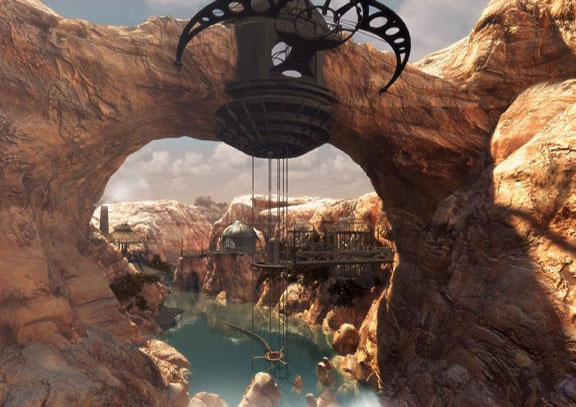
• Tomahna: Familiar if you’ve played Exile – but this time, you’re exploring the main part of it! Tomahna is Atrus’ home and base of operation, where he and Catherine have raised Yeesha for the past ten years. Life in Tomahna is relatively calm and quiet, save for when Atrus makes a few mistakes (as he usually does), but that idyllic life is about to be shattered in this game. The neat thing is that we once again get to see Atrus’ porch and office, which is a blast from the past to Exile fans. There’s even a hidden memory of Saavedro breaking in to steal Releeshahn if you use Yeesha’s amulet in a certain spot!
• Spire: Spire is located in a red book, but it’s not just a red book. It’s the Red Book. The book Sirrus was trapped in during Myst and that you thought was destroyed. Spire itself is a harsh and seemingly uninhabitable chunk of floating rock that orbits a strange-looking greenish star. The way the rocks have eroded seem like fine architecture and the crystals that decorate it makes this age seem absolutely beautiful, but this is a façade to fool greedy travelers. In reality, Spire is racked by powerful storms and chilling cold; even the meager plant life tastes bitter. Spire is also layered; each layer is cloaked by clouds, making it impossible to see the bottom until you reach it – and because it’s orbiting some sort of star, there really is no bottom. With conditions like these, it’s no wonder Sirrus went a little loopy trying to find the way home. Spire is ruled by the colors blue and green, making the age feel cold even through the computer screen.
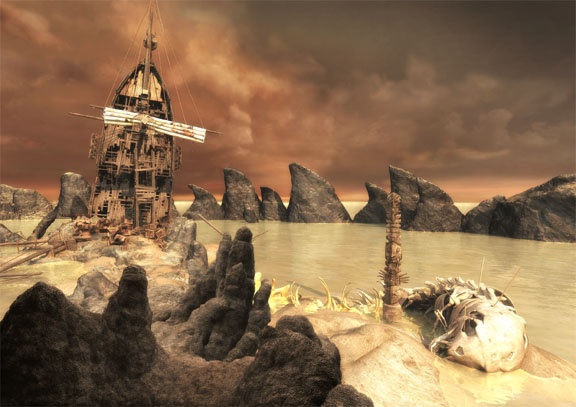
• Haven: If Spire is the Red Book, then Haven is the Blue Book. Haven is far more hospitable, though it doesn’t seem like it at first. It seems rather harsh and dark when you first arrive, with is muddy beaches, dirty ocean, and spooky wrecked ship, but as you further explore the age, you can see a lush jungle with a myriad of animal and plant life. Though extremely hot and wet, Haven is definitely much nicer compared to Spire. Between some of the rather cute animal life and gorgeously tropical surroundings, it’s hard for a criminal like Achenar not to have changed his ways – at least a little bit. Haven is dominated by the colors red, orange, yellow, and brown; warmer colors are present even in the swampy areas of the age. The overall effect is one of a hot, but beautiful, environment.
• Serenia: The final age on your journey, Serenia is an age written by Catherine, and as such is extremely odd. This age is actually a sort of religious island for the age’s inhabitants, known as Serenians. The island is guarded by a handful of chosen women known as Protectors who keep an eye on the island and sort of act as nuns, monks, and priests, all in one. You even get to experience a little bit of their religious procedures yourself. I won’t go into the theology of the Serenian race here – for that, you’ll have to play the game. Serenia is bright and calm, and as the name would suggest, the atmosphere is one of serene beauty. This age is dominated by light colors, such as pastels and cool grays, making the age seem like somewhere you’d go for vacation.
 Because
of Presto Studio’s closing and Cyan Worlds’ current commitment to
the then in-development Uru Live, the development of Myst IV: Revelation
fell to DreamForge Entertainment, who had actually been hired before Presto
Studios to help design Myst III: Exile! Not wanting to intrude on DreamForge’s
ideas, Presto Studios scrapped the plot idea they had originally planned for
Exile – that of the brothers returning – and the plot idea
stayed that way until DreamForge was once again commissioned to do another Myst
game. DreamForge’s idea of Myst IV: Revelation was about twenty
percent complete, but by that time Ubisoft had acquired the rights to the Myst
franchise, and they decided to start the development of the game over from scratch.
Because
of Presto Studio’s closing and Cyan Worlds’ current commitment to
the then in-development Uru Live, the development of Myst IV: Revelation
fell to DreamForge Entertainment, who had actually been hired before Presto
Studios to help design Myst III: Exile! Not wanting to intrude on DreamForge’s
ideas, Presto Studios scrapped the plot idea they had originally planned for
Exile – that of the brothers returning – and the plot idea
stayed that way until DreamForge was once again commissioned to do another Myst
game. DreamForge’s idea of Myst IV: Revelation was about twenty
percent complete, but by that time Ubisoft had acquired the rights to the Myst
franchise, and they decided to start the development of the game over from scratch.
Ubisoft essentially decided on the same plot as DreamForge did – that
of the brothers returning – and got to work. Cyan Worlds, always the authority
figure for the series, laid down a set of ground rules for Ubisoft to follow,
but otherwise left Team Revelation, as it was called, to their own devices.
Ubisoft decided that Revelation, like its predecessors, would be pre-rendered,
meaning that all of the scenery in the game would be built from the start and
everything else that moved would be layered over it. This was challenging for
Ubisoft, because they’d never built a pre-rendered game before. To solve
this, they hired upwards of fifty new employees who knew how to work with pre-rendering
and went from there. Unfortunately, the game started production before the developers
and art directors knew what to do, resulting in tension between the members
of Team Revelation.
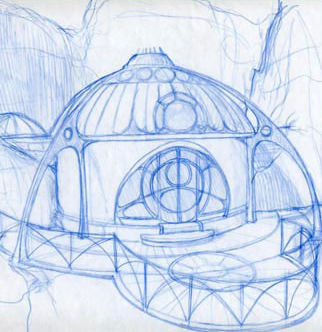
The Team added several new features, building off of the 360-degree camera rotation
of Exile and the hub age idea of Myst. To heighten the realism
of the game, a revolutionary new game engine called ALIVE was used to animate
everything in the game, from moving clouds to trees shifting in the breeze.
It also employed more interactivity with game characters – for example,
animals in Haven sometimes approach the player or respond to the player’s
action. Not only that, dynamic light effects were used, such as lens flares
and an optional ‘fisheye-lens’ effect that mimics that of human
vision by blurring the edges of the screen slightly, the same way our eyes do.
Myst IV: Revelation has over 70 minutes of video, with which players
can interact with and look away from while it’s playing.
New features were also added to the gameplay. The traditional hand-shaped cursor
used for Myst, Riven, and Exile got a facelift and
several new functions, such as tapping, dragging, and sliding features. Zip
Mode, a feature used to bypass walking and save time in the game, was redesigned
entirely – now the player could choose from certain scenes and move right
to them, a very helpful function. The player also gains a camera, used to take
photos and handy for grabbing puzzle solutions; a journal for jotting notes
down, and an amulet that can provide clues to the plot. The plot explains that
the amulet is a Serenian trinket that Yeesha owns, used to see memories from
the past, as evidenced when Yeesha herself says that “[Her] amulet shows
[her] things.” That girl is seriously one creepy child.
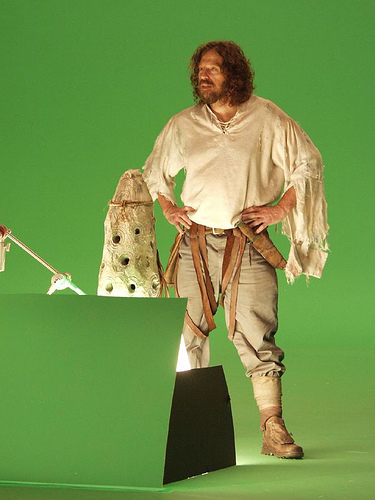 Some
traditions, however, never change. In keeping with the previous four games,
Revelation used live actors for each of the characters – all
hired either from Montreal or Canada at large. Improv actor and comedian Brian
Wrench was chosen for the role of Sirrus, mainly because he looked the role,
and Wrench accepted. Canadian actor Guy Sprung was chosen as Achenar, and a
young Québécois lady named Juliette Gosselin was chosen for the
role of Yeesha. Not surprisingly for a company based in Quebec, the game’s
dialogue was first recorded in French and then in English. This caused a few
minor issues with audio synching, something that jaded a few Myst fans
but was seen as an acceptable error. Unlike the previous three games, a greenscreen
backdrop like those used in movies was used instead of the older bluescreen
technology, as green is thought to better contrast human skin color. Like the
previous Myst games, each actor was rotoscoped and Chroma Keyed into
their surroundings in the game.
Some
traditions, however, never change. In keeping with the previous four games,
Revelation used live actors for each of the characters – all
hired either from Montreal or Canada at large. Improv actor and comedian Brian
Wrench was chosen for the role of Sirrus, mainly because he looked the role,
and Wrench accepted. Canadian actor Guy Sprung was chosen as Achenar, and a
young Québécois lady named Juliette Gosselin was chosen for the
role of Yeesha. Not surprisingly for a company based in Quebec, the game’s
dialogue was first recorded in French and then in English. This caused a few
minor issues with audio synching, something that jaded a few Myst fans
but was seen as an acceptable error. Unlike the previous three games, a greenscreen
backdrop like those used in movies was used instead of the older bluescreen
technology, as green is thought to better contrast human skin color. Like the
previous Myst games, each actor was rotoscoped and Chroma Keyed into
their surroundings in the game.
Jack Wall, the composer of Exile’s music, was once again commissioned
for the soundtrack of the game. For this game, he decided that the score for
this game would be more ‘civilized’ than Exile’s,
as he wasn’t looking at a foreign and unforgiving environment anymore.
Wall also wanted to incorporate some themes from Myst and Riven,
mainly the brothers’ themes and Atrus’ theme, and he expanded, orchestrated,
and re-orchestrated these themes extensively. While Wall’s Exile
score was based more on tribal influences, the score for Revelation
was based more on Eastern European music. For Tomahna, warm and curious themes
are used, marking Atrus’ curiosity about the world and other worlds along
with a sense of coming home. Spire’s themes were appropriately cold, stark,
despairing, and bleak, while Haven’s themes went from dark and brooding
to warm and inviting. Serenia’s themes were appropriately dreamy and calming.
In addition to Wall’s soundtrack, a song by songwriter Peter Gabriel entitled
Curtains was also in the game. The song was originally from the B side
of his single CD Don’t Give Up. Gabriel also provided a voiceover
for a minor character in the game.
Revelation was a success overall, gaining positive comments on its
graphics and interactivity. Jack Wall’s score was applauded, as his score
for Exile had been, and the new features were a huge hit. Many reviewers
who found Uru: Ages Beyond Myst to be a disappointment were pleasantly
surprised by this game, and their reviews showed it. Critics pointed out Revelation’s
steep computer requirements, which called for not only a DVD-ROM drive but seven
gigabytes of free harddrive space on the computer itself! Other issues called
out were the sluggishness of the cursor’s movements (Easily fixed in the
options section of the game's main menu) and tedious node-based travel. Revelation
is also the only Myst game to receive a T rating, most likely for the
swearing present in Achenar’s journals. Various Myst fans, mainly
the older ones, felt that Revelation was ‘too mystical’
due to some of the events in Serenia, but most liked the new additions to the
game and felt it a worthy addition to the Myst series and a great game
overall.

In the Myst community, Revelation’s puzzles are considered to be some of the hardest to solve since Riven’s mind-bashers. It’s no surprise, then, that you may find yourself stuck in Spire – especially if, like me, you are terrible at math – Haven, Serenia, or even Tomahna! While I can’t fix computer issues that Revelation may have caused, I can provide the two walkthroughs below. The first is Universal Hint System’s Revelation walkthrough, which is low-spoiler and reveals subtle hints. I highly recommend this one if you’re playing for the first or second time. The second one is a full-spoiler walkthrough and will reveal the entire game for you. If you’re really stumped, go ahead and use this walkthrough, but I warn you – you’ll hate yourself for spoiling your game like that.
Low-Spoiler
Walkthrough ~ Full-Spoiler
Walkthrough